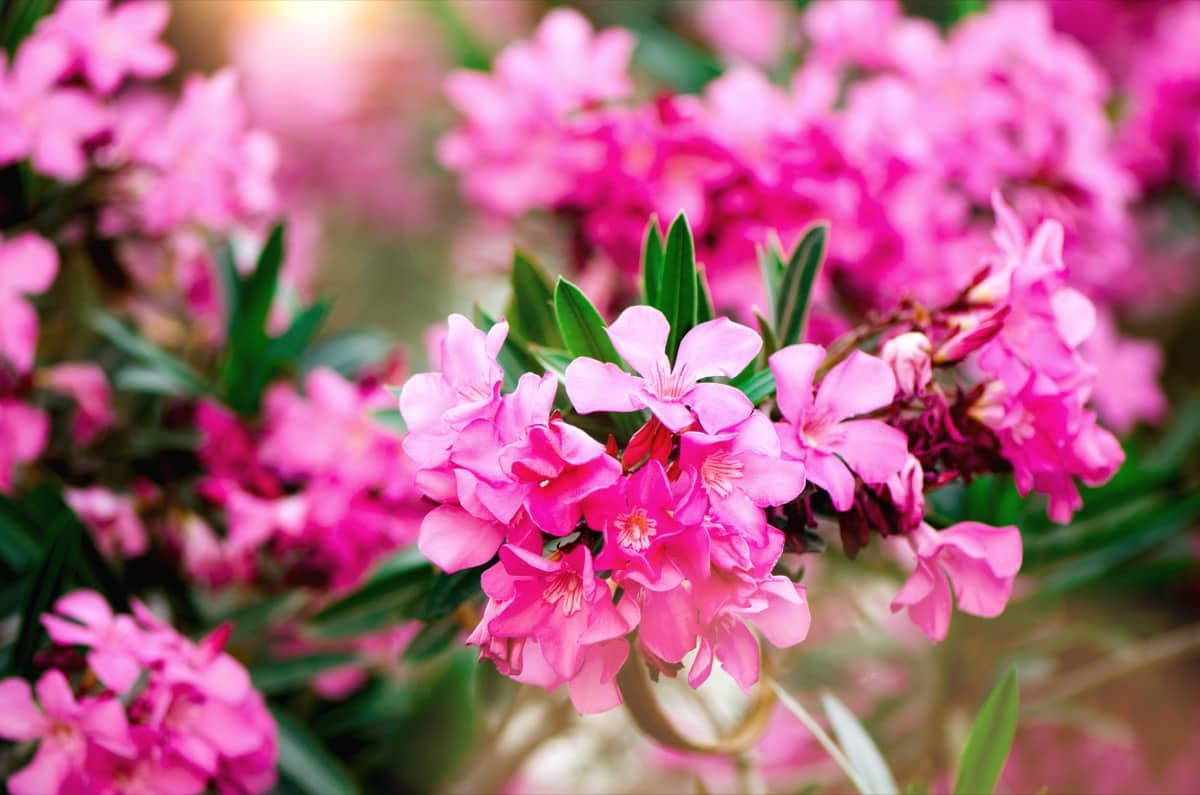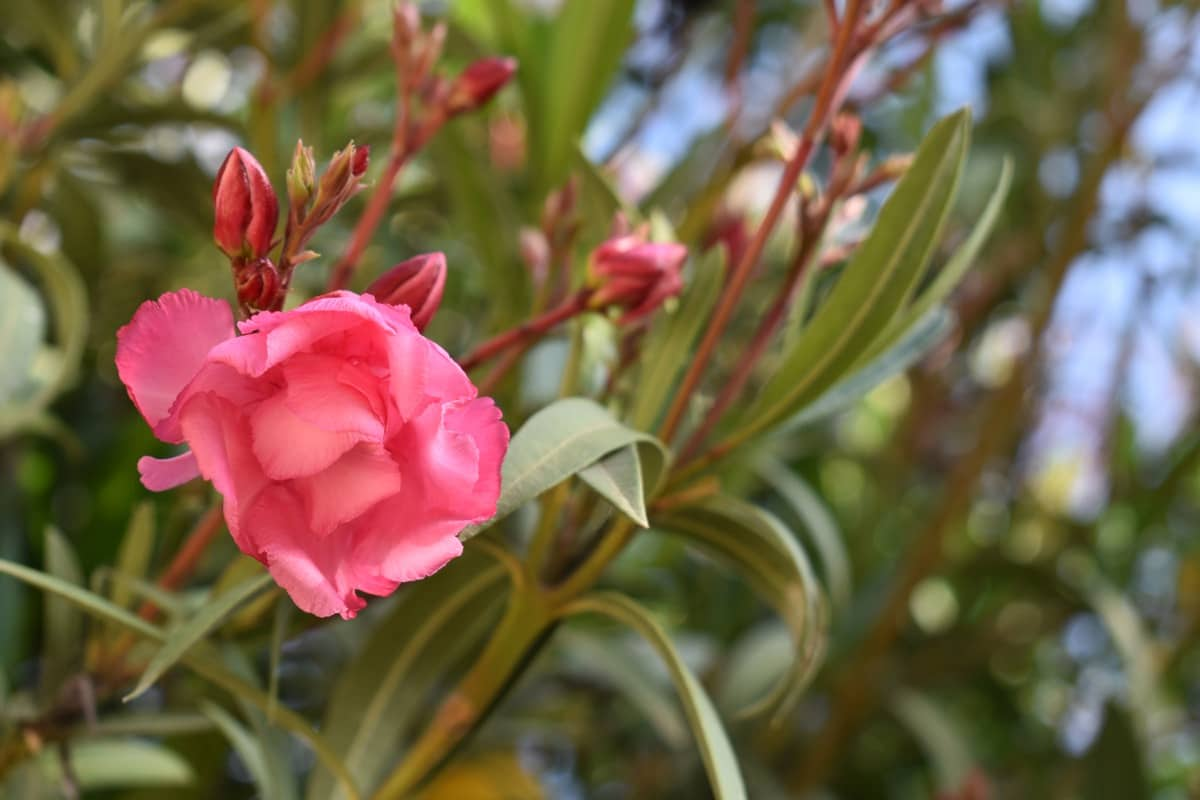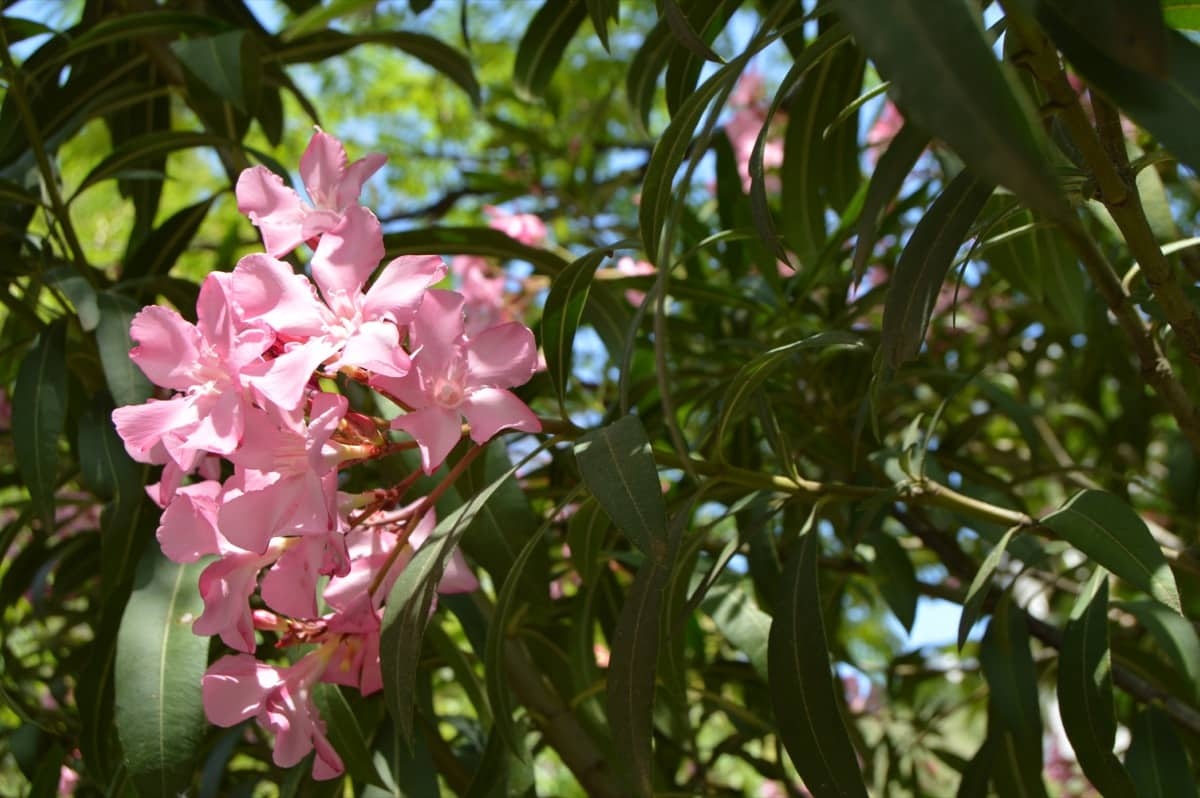Welcome to our blog on Common Nerium plant pests and control! This article will explore the causal organisms, damage symptoms, spread, treatment options, prevention strategies, and management techniques for these pests. Connect with us to discover ways to safeguard your nerium plants and guarantee a nice crop. So, let’s get started.

Major and Common Damaging Nerium Pests
Nerium, commonly called oleander, is a perennial flowering evergreen or semi-evergreen shrub in the Apocynaceae family, native to the eastern Mediterranean, parts of North Africa, and the Arabian Peninsula, reaching 2 to 6 meters in height. The leaves are long, narrow, and arranged in whorls along the stem, giving the plant an attractive, symmetrical appearance.
Its flowers are striking and come in shades of white, pink, and red, often with intricate patterns and delicate fragrances. It is important to note that Nerium plants contain toxic compounds and should be handled with care.
| Pest | Characteristic Symptoms |
| Oleander Aphids | Present on lower leaf surfaces, honeydew, & sooty mold. |
| Thrips | Black specks, discoloration & scarring of petals & flower buds. |
| Red Spider Mites | Yellowing or stippling, protective webbing, and bronzing. |
| Mealybugs | Cottony wax coating, chlorosis, honeydew, & sooty mold. |
| Cottony Cushion Scale Insect | Cottony egg masses, honeydew, sooty mold, & dieback. |
| Leaf Miner | Serpentine mines & premature leaf drop. |
| Sphingid Caterpillar | Leaf skeletonization, ragged leaf edges, & defoliation. |
| Glassy-Winged Sharpshooter | Yellowing and wilting, leaf scorch, honeydew, & sooty mold. |
| Red Palm Weevil | Round exit holes, tunneling, drying, and collapse of fronds. |
| Silverleaf Whitefly | Yellowing and wilting, honeydew, & sooty mold. |
How to Identify and Treat Nerium Pests
Oleander Aphids Pest Control in Nerium
- Causal Organism: Aphis nerii
- Symptoms: The characteristic symptom is a cluster of small, soft-textured insects that suck the sap from new growth and flower buds on lower leaf surfaces. Infested plants show leaf curling, chlorosis, distortion, honeydew excretion, sooty mold, and reduced plant vigor.
- Favorable Conditions: They prefer warm and moist conditions of 28-35 °C, tender growth, crowded plantations, and stressed plants for feeding, reproduction, and survival.
- Treatment: Spray insecticidal soaps, imidacloprid, or acetamiprid. Practice pruning, sanitation, and monitor plants regularly for early detection. Use jet spray to dislodge aphids from the plant. Release natural predators like ladybugs and lacewings.
Thrips Pest Control in Nerium
- Causal Organism: Frankliniella occidentalis
- Symptoms: Thrips damage leaves by rupturing the chlorophyll and forming brown or black specks on leaves. Infested plants show leaf deformation, silvering, or discoloration of petals and flower buds, frass droppings, and leaf and flower scarring.
- Favorable Conditions: They prefer warm and arid weather conditions of 27-32 °C, succulent tissues, areas with low rainfall, and crowded plantations for reproduction.
- Treatment: Spray pyrethroids, spinosad, acetamiprid, or imidacloprid. Remove and destroy infested flowers and weeds and monitor the plants regularly. Use jet spray, reflective barriers, and natural predators like predatory mites and minute pirate bugs.
Red Spider Mite Pest Control in Nerium
- Causal Organism: Tetranychus urticae
- Symptoms: The characteristic symptom is the yellowing or stippling of leaves caused by feeding damage. Infested leaves show protective webbing structures on leaves and stems, bronzing, distortion, curling, premature leaf drop, and reduced vigor.
- Favorable Conditions: They prefer warm and dry environments of 27-35 °C and < 40% humidity, overcrowding, drought conditions, poor airflow, and infected plant debris.
- Treatment: Spray pyrethroids, abamectin, fenazaquin, etoxazole, and spiromesifen. Remove and destroy heavily infested leaves. Use jet spray to enhance humidity and predatory mites to control the pest.
Mealybug Pest Control in Nerium
- Causal Organism: Planococcus spp.
- Symptoms: The most noticeable symptom is the white, cottony, or waxy coating on stems, leaf axils, and leaf undersides for protection and regulating moisture. Infested plants show leaf chlorosis, wilting, distortion, honeydew, sooty mold, and reduced plant vigor.
- Favorable Conditions: They prefer moderate temperatures and humid environments of 20-25 °C and > 80% humidity, succulent plant growth, poor airflow, infested plant debris, and overcrowding.
- Treatment: Spray insecticidal soaps, imidacloprid, or thiamethoxam. Practice regular monitoring and physical removal using a cotton swab dipped in alcohol. Prune and destroy heavily infested plant parts. Use ladybugs and lacewings.
In case you missed it: Common Anthurium Pests: Symptoms, Control, Treatment, and Prevention

Cottony Cushion Scale Insect Pest Control in Nerium
- Causal Organism: Icerya purchasi
- Symptoms: The characteristic symptom is the presence of large, white, cottony egg masses on stems and leaves. Infested plants show leaf chlorosis, wilting, distortion, honeydew, sooty mold, stunted growth, and dieback.
- Favorable Conditions: They prefer mild to warm and mildly humid weather of 15-27 °C and 40-50% humidity, tender growth, poor air circulation, overcrowding, and areas with less or no natural predators for reproduction and survival.
- Treatment and Management: Spray neem oil, insecticidal soaps, imidacloprid, or dinotefuran. Practice sanitation, pruning, monitoring the plants regularly, and using cotton dipped in rubbing alcohol and ladybugs or parasitic wasps.
Nerium Leaf Miner Pest Control in Nerium
- Causal Organism: Phyllocnistis spp.
- Symptoms: The prominent symptom is the presence of winding, serpentine mines on leaves. Infested leaves show curling, distortion, reduced plant vigor, premature leaf drop, and stunted growth.
- Favorable Conditions: They prefer warm and humid environments of 28-34 °C and > 70% humidity, new tender growth, and infested plant debris for oviposition and larval feeding.
- Treatment and Management: Spray abamectin, imidacloprid, spinosad, or thiamethoxam. Practice pruning and destroying infested leaves and monitoring the plants regularly. Use sticky traps to monitor and parasitic wasps to control the pest.
Sphingid Caterpillar Pest Control in Nerium
- Causal Organism: Deilephila nerii
- Symptoms: The characteristic symptom is the caterpillar feeding damage by chewing on leaf tissues, resulting in a characteristic pattern of skeletonization. Infested plants show irregular holes, ragged leaf edges, extensive defoliation, frass, and reduced overall health.
- Favorable Conditions: They prefer warm and humid environments of 25-30 °C, nectar food sources, dense vegetation, and minimal disturbance.
- Treatment and Management: Spray Bt-based insecticides, pyrethroids, or spinosad. Practice handpicking and squashing them immediately, monitor the plants regularly, pruning, sanitation, and use parasitic wasps and birds.
Glassy-Winged Sharpshooter Pest Control in Nerium
- Causal Organism: Homalodisca vitripennis
- Symptoms: The primary symptom is the yellowing and wilting of leaves. Infested plants show leaf scorch, burn, drying at leaf margins, sticky honeydew excrement, and sooty mold.
- Favorable Conditions: They prefer mild to warm and humid conditions of 21-28 °C and > 70% humidity, overcrowding, infested plant debris, and areas with less or no natural predators.
- Treatment and Management: Spray imidacloprid, bifenthrin, or spinosad. Practice pruning and sanitation of heavily infested plant material. Control weeds and avoid overhead irrigation.
Red Palm Weevil Pest Control in Nerium
- Causal Organism: Rhynchophorus ferrugineus
- Symptoms: The characteristic symptom is the presence of round exit holes on the stems and frass (sawdust-like material) around the base. Infested plants show wilting, drying, and collapse of fronds, visible tunneling, and damage to the inner stem tissues.
- Favorable Conditions: They prefer warm and humid conditions of 27-38 °C and >60% humidity, stressed or wounded plants, poor air circulation, weeds, and overcrowding for growth and development.
- Treatment and Management: Spray chlorpyrifos, emamectin benzoate, and imidacloprid. Practice pruning, sanitation, and monitoring the plants regularly. Use pheromone traps to monitor the pest and avoid mechanical injuries.
In case you missed it: How to Treat Pests of Guava Tree: Symptoms, Prevention, and Control

Nerium Silverleaf Whitefly Pest Control in Nerium
- Causal Organism: Bemisia tabaci
- Symptoms: The characteristic symptom is the yellowing and wilting of leaves due to feeding damage and honeydew secretion. Infested plants show white, waxy material on the undersides of leaves, leaf curling, distortion, sooty mold, reduced flowering, and vigor.
- Favorable Conditions: They prefer warm and moist weather of 21-32 °C and >70% humidity, weeds, crowded plantations, and low air circulation for development and reproduction.
- Treatment and Management: Spray neonicotinoids, pyrethroids, insect growth regulators, imidacloprid, or acetamiprid. Practice pruning, sanitation, removing and destroying heavily infested leaves regularly. Use sticky traps, reflective mulches, or aluminum foil to deter the pest. Release ladybugs, lacewings, or parasitic wasps.
Conclusion
Some major pests affecting nerium plants include aphids, thrips, red spider mites, mealybug, cottony cushion scale insects, leaf miners, sphingid caterpillars, glassy-winged sharpshooter, weevils, and whitefly pests. Various organisms cause these pests and exhibit specific symptoms, modes of spread, and management approaches.
- Beneficial Insects in Pest Management
- Natural Solutions for Pest Control in Flower Gardens
- Types of Fungicides Used in Agriculture
- Common Issues in the Fruit Development Stage of Pomegranate Farming
- Fruit Development Issues in Papaya: Easy Solutions and Treatment
- Soil-Borne Diseases and How to Protect Your Plants
- Practices to Prevent Disease Spread in the Garden
- From Wilted to Thriving: How to Treat Root Rot Naturally in Houseplants
- Natural Remedies to Cure Brown Spots on Fig Tree Leaves